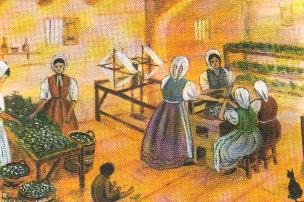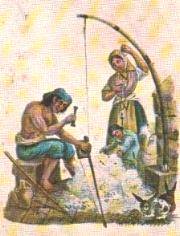
|
|
|
IS-SNAJJA TAL-IMGHODDI ID-DUDU TAL-HARIR Kitba u Stampi ta" Guido Lanfranco
 Tul iz-zminijiet biex jaghmel id-drappijiet ghall-ilbies tieghu, il-bniedem irnexxielu jislet hajt mill-annimali, hxejjex u nsetti. Izda l-aktar li rnexielu naghmel kienu l-qoton mill-hxejjex u s-suf mill-annimali Fil-waqt li I-annimali li minnhom jigi s-suf huma mdaqqsin sewwa, bhan-nghag, hemm annimali ohrajn li minnhom il-bniedem tal-lvant beda jaghmel il-harir, hajt mill-aktar fin u jleqq. Mhux biss ghax fin u jleqq il-barir jiswa hafna flus, izda ghax biex taghmlu trid xogbol delikat aktar minn dak tat-tajjar jew tas-suf. Fil-lvant hemm (u kienu jghixu aktar) speibi ta' nsetti mir-razza tal-friefet u l-bahrija, li jipproteou l-fosdqa taghhom b'hafna hajt tal-harir. Kulhadd jaf li l-hajja tal-bahrija tixbah hafna lil dik tal-farfett, u ghalhekk tibda l-ewwel bhala bajda li tfaqqas f'dudu, jew xaghat, li ftit ftit jikber u jistrieh f'ghamla ta' fosdqa. Fil-bahrija li cled insemmu, il-fosdqa ssir mohbija go ballun ovali tal-harir li d-dudu jkun dawwar madwaru. Wara A tmien il-fosdqa tinfetah gbax id-dudu jkun sar babrija, itaqqab il-ballun harir ta' madwaru, jifrex il-gwienah u jtir.
Izda billi l'bahrija tkun taqqbet il-harir ta' madwarha biex tohrog, il-hajt ma jibqax shih. Ghalhekk min kien beda jiehu l-harir minn din il-bahrija, kien jismot il-ballun harir bil-fosdqa hajja go fiha b'kollox biex il-harir ma jittaqqabx, u b'xorti hazina l-bahrija tmut qabel ma tohrog. Izda ghadd kbir kien jinzammu hajjin biex minnhom jiehdu l-bajdiet halli jrabbu aktar. Hawn Malta fi zmien Pinto, u wkoll fi zmien il-gvernaturi Hastings u Reid, kienu ppruvaw din l-industrija tal-harir fuq skala zghira, izda d-dud bdew jimirdu wisq u l-prodott ma kienx ekonomiku. F'Malta kienu jigbru wkoll u hawlu ghadd kbir ta sigar tac-cawsli fis-seklu li gbadda biex jiekol fuqhom id-dudu tal-bahrija tal-harir.
|
|
INFORMATION ABOUT SILKWORMS History The discovery of the product silk from the silkworm species Bombyx mori occurred around 2700 BC. According to Chinese tradition the bride of Emperor Huang Ti, a 14-year-old girl called Hsi Ling Shi, discovered the invention of the first silk reel. Sericulture, the cultivation of the silkworm, spread through China making silk a highly valued commodity much sought after by other countries. In 139 BC the world's longest trade route was opened stretching from Eastern China to the Mediterranean Sea. It was named the Silk Road after its most valuable commodity. By 300 AD the secret of silk production had reached India and Japan. Silk manufacture eventually reached Europe and America. During the 18th and 19th centuries Europeans produced several major advancements in silk production. By the 18th century England led Europe in silk manufacturing because of English innovations in the textiles industry. These innovations included improved silk-weaving looms, power looms and roller printing. Between 1855 and 1865 an epidemic called Pebrine disease, caused by a small parasite, raged through the industry. It was the French scientist Louis Pasteur who discovered that this could be prevented through simple microscopic examination of adult silkmoths. Much research was carried out on silkworms at this time, ultimately setting the stage for a more scientific approach to silk production. Silk production today is a combination of old and modern techniques. Bombyx Mori Silkworm is a common name for the silk-producing larvae of any of several species of moths. The larva is not really a worm at all but a caterpillar. There are several species of silkworm that are used in commercial silk production, however Bombyx mori is the most common. Silkworms possess a pair of specially modified salivary glands called sericteries, which are used for the production of a clear, viscous, proteinaceous fluid that is forced through openings called spinnerets on the mouthpart of the larva. As the fluid comes into contact with the air it hardens. The diameter of the spinneret determines the thickness of the silk thread, which is produced as a long, continuous filament. Typical Commercial Silkworm Production The first stage of silk production is the hatching of the silkworm eggs, in a controlled environment such as an aluminium box, which are then examined to ensure they are free from disease. The female deposits 300 to 400 eggs at a time. In an area the size of this page around 50 moths would deposit more than 20,000 eggs, each about the size of a pinhead. The female dies almost immediately after depositing the eggs and the male lives only a short time after. The adult possesses rudimentary mouthparts and does not eat during the short period of its mature existence. These disease-tested eggs are raised in temperature and disease-controlled conditions. They are fastened to a flat surface by a gummy substance secreted by the female. The larvae hatch in about 10 days and are about 0.6cm long. Once hatched, they are placed under a layer of gauze and fed huge amounts of chopped mulberry leaves during which time they shed their skin four times. The larvae may also feed on Osage orange or lettuce. Larvae fed on mulberry leaves produce the very finest silk. The larva will eat 50,000 times its initial weight in plant material. After it has achieved its maximum growth of 7.5cm at around 4 to 6 weeks, it stops eating, changes colour and attaches itself to a compartmented frame, twig, tree or shrub in a rearing house to spin a silk cocoon over a 3 to 8 day period. This is period is termed pupating. A Hard Day’s Night Steadily over the next four days the silkworm produces a fine thread by making a figure of eight movement some 300,000 times, constructing a cocoon in which it intends to spend the chrysalis stage where it is in a state of sleep and casting off its skin. After this the pupae begin the sixteen days that would normally result in the miracle of transformation to a winged being - the moth. However, if the pupa (chrysalis) remains alive it will begin to secrete an alkali, which eats its way through the cocoon, ruining the silk threads. Therefore during the commercial production of silk, only enough adult moths are allowed to emerge to ensure continuation of the species. Most of the remainder of the silkworms are killed by heat, e.g. immersion in boiling water, steaming or drying in an oven. Hundreds Die The amount of useable silk from each cocoon is small. One hectare of mulberry trees yields 11.25 tonnes of leaves, producing around 200kg of cocoons, but just 40kg of raw silk. The silk yield is many times smaller than this in countries such as Thailand, where the silk is reeled by hand rather than by machine. So it takes hundreds of tiny lives to produce just one silk scarf or tie. |
 Launched on the 7 April, 1999 Updated Periodically - Please, visit this site often. Copyright 2007-08
You are visitor no:
|
 Il-bniedem sab li dawn il-blalen madwar ii-fosdqa kienu jistghu jinhallu f'hajt tal-harir jekk jitqeghdu fl-ilma shun.
Il-bniedem sab li dawn il-blalen madwar ii-fosdqa kienu jistghu jinhallu f'hajt tal-harir jekk jitqeghdu fl-ilma shun.